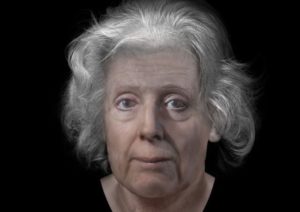Witchcraft and mystery, or, the object that never was in our collection
Jessica Burdge and Katie Eagleton
Every museum has at least one object that people sometimes ask about, but which actually isn’t in their collection. For the Museums of the University of St Andrews there is an added layer of mystery, because ours is a witch skull, and we can’t illustrate this blog with a photograph of it, because it has disappeared.

More than 300 years ago, Lilias Adie from Torryburn, Fife, was accused of witchcraft. She died in prison in 1704, before the sentence of execution could be carried out, and her remains were buried on the beach weighed down by a large stone, which was said to be to stop her coming back to haunt people. In the 19th century, her remains were exhumed, and accounts you can find online today usually say that the skull was initially in the private collection of a doctor in Dunfermline, then in the University of St Andrews anatomy collection – but went missing sometime in the 20th century. Today, more than 300 years after Adie’s death, there are attempts to find her remains, and to more respectfully remember her and others who were tried for, and convicted of, witchcraft in Scotland.
It’s a story that has all the elements of a mystery story: witchcraft and a disappearing skull. As a result, we receive reasonably regular queries asking where the skull is now, and what records we have of it in our collection in the past?
The St Andrews connection seems to begin on 30th September 1884, when twelve men of the Fifeshire Medical Association met at St Andrews, in the classroom of Professor Pettigrew, anatomist at the University. The first talk was on the history of the University, and the second talk was on Lilias Adie. Dr William Barrie Dow from Dunfermline showed her skull to the gentlemen present, explained his observations on it, and read extracts from the Kirk-Session records. There was then a third talk on the then-recently-described tuberculosis bacterium, including viewing of specimens through microscopes, before everyone repaired to the Cross Keys Hotel for dinner and speeches to celebrate Dr Dow having been elected President of the Association for the coming year (Dundee Evening Telegraph, 2 October 1884, page 3).
It is not clear who owned the skull in 1884 – or, indeed, whether the group took it to the Cross Keys with them – but in the published version of his talk, Dow named Robert Couston (who had not been present at the meeting) as the former owner of the skull. Sometime around the turn of the century, although it is not known where or by whom, three photographs of the skull were taken, and it is these that have recently allowed a reconstruction of Adie’s face to be created by specialists at the University of Dundee. In 1901 and 1904, Robert Couston published articles about Lilias Adie in the Dunfermline Press in which he said that her skull had come to the St Andrews Museum.
The problem is, we can find no trace of it.
From 1838 onwards, the St Andrews Literary and Philosophical Society, who were responsible for the museum at the University, kept detailed lists of objects acquired for the collection, and in those there is no mention of anything that could be this skull. Nor is it included in a complete list of the museum and its collection that was compiled in 1904 when the Literary and Philosophical Society formally handed both over to the University. These records are detailed, but to be sure that the skull wasn’t somehow in the collection without proper documentation, we took copies of the photographs of Lilias Adie’s skull (which has distinctive and prominent front teeth) and compared it with the skulls in the Anatomy and Pathology collection. None were similar. The trail, at this point, goes cold, and we can only conclude that Lilias Adie’s skull was probably never part of the collections at the University of St Andrews.
However, readers who know the history of the University and the history of its museums may have spotted a coincidence of locations here, that might be the key to unlocking this mystery. That is, Professor Pettigrew’s rooms at the University were in the United College Building, only a few hundred metres from the location of the University Museum, which in 1884 was in Upper College Hall.
Perhaps, then, there is no witchcraft and no mysterious disappearance here at all – if statements that the skull was in the University of St Andrews Museum trace back to newspaper reports by someone who wasn’t there, published 15 years later, of an evening in 1884 when a group of medical gentlemen examined Adie’s skull at the University close to – but not in – the University Museum.
The last time the location of Lilias Adie’s skull was known was in 1938 when it was displayed along with other objects relating to witchcraft as part of the Empire Exhibition in Glasgow, in one of the two Scottish pavilions. One contemporary newspaper reported that it “grins from a showcase”, and repeats Couston’s statement that the skull had previously been in the collections of the University of St Andrews but gives no details about who at that point owned it (Falkirk Herald, 16 July 1938, page 7). Records of the Empire Exhibition are now held in the University of Glasgow Archives but the Hunterian Museum has no record of Lilias Adie’s skull being deposited in their collection, so it may be that it is still in a private collection somewhere.
The search continues.